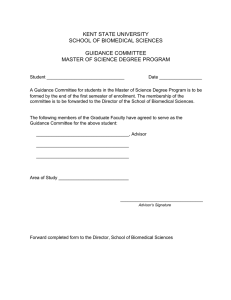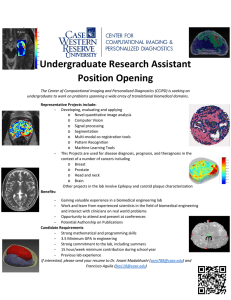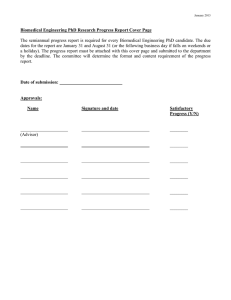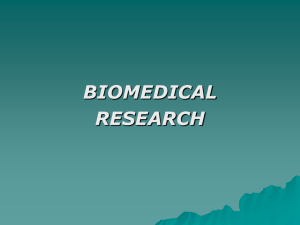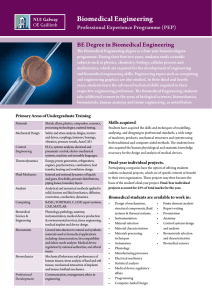M.Tech Bio-Medical Engg.
advertisement
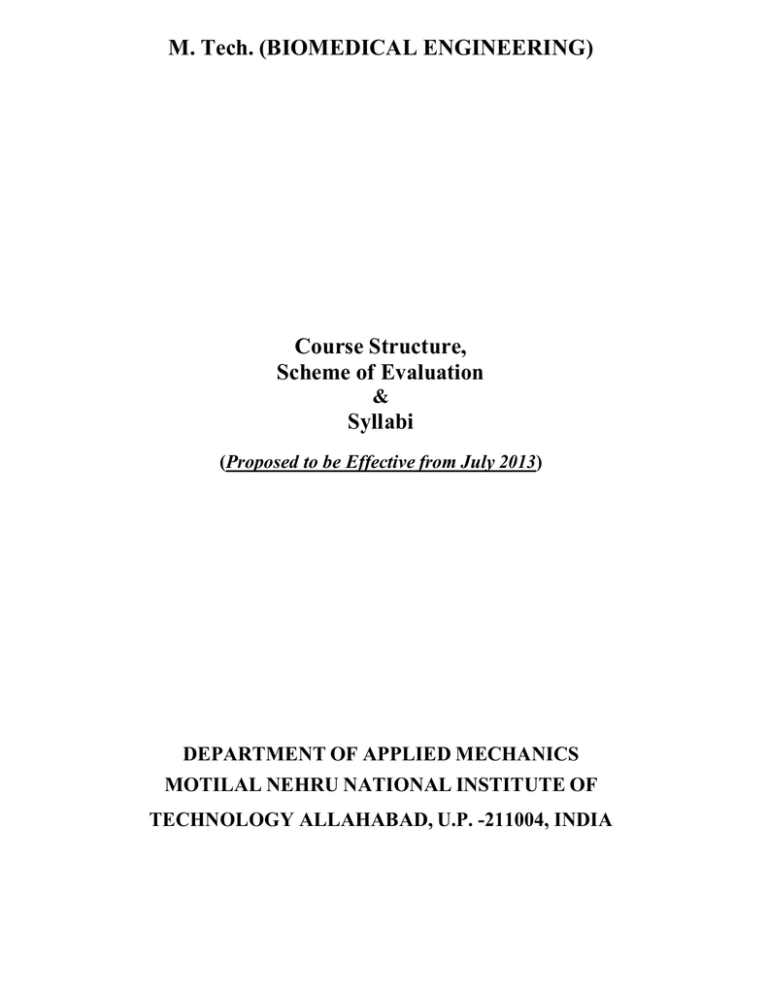
M. Tech. (BIOMEDICAL ENGINEERING) Course Structure, Scheme of Evaluation & Syllabi (Proposed to be Effective from July 2013) DEPARTMENT OF APPLIED MECHANICS MOTILAL NEHRU NATIONAL INSTITUTE OF TECHNOLOGY ALLAHABAD, U.P. -211004, INDIA M.Tech. (Biomedical Engineering) I Semester (Total credit = 20) Course code Subject Name AM2101 AM2102 AM21XX AM21XX AM21XX Continuum mechanics Applied Mathematics & Computation Elective-I Elective-II Elective-III L T P Credits 4 4 4 4 4 0 0 0 0 0 0 0 0 0 0 4 4 4 4 4 Distribution of Marks out of 100 TA Mid Sem. Exam End Sem. Exam 20 20 20 20 20 20 20 20 20 20 60 60 60 60 60 List of Electives (Semester I): Elective-I: Elective-III: & Physiology AM2133 Anatomy Biomedical Engineers ME2118 Ergonomics for AM2134 Biomedical Instrumentation AM2135 Biomedical Signal and Image Processing AM2136 Effects of Radiation and Biomedical AM2137 Biological System Analysis and Application of Radiation Control Elective-II: AM2138 Introduction to Biomedical Design AM2116 Biomechanics ME2125 Computer Aided Design and their AM2139 NDT-Techniques Biomedical Applications II Semester (Total credit= 20) Course Subject Name code AM2207 AM2208 AM22XX AM22XX AM22XX Advanced Biomechanics Biomaterials Elective-IV Elective-V Elective-VI L T P Credits Distribution of Marks out of 100 T Mid Sem. End Sem. A Exam Exam 4 4 4 4 4 20 20 20 20 20 0 0 0 0 0 0 0 0 0 0 4 4 4 4 4 20 20 20 20 20 60 60 60 60 60 List of Electives (Semester II): Elective-IV: Engineering AM2254 Biomedical Laboratory (L-T-P: 0-0-6) AM2241 Biomedical Ethics, Standards & IPR Issues AM2239 Electro Physiological signal Analysis Elective-V: AM2237 Bio-fluid Dynamics AM2224 MEMS and Bio- MEMS AM2240 Electro Diagnostics, Therapy and Electrical Safety AM2201 Finite Element Methods Elective-VI: Engineering AM2236 Rehabilitation Technology AM2238 Medical Imaging AM2243 and Assistive Tissue Engineering AM2242 Artificial Intelligence in Biomedical Engineering III Semester(Total credit= 20) S.N. Subject Name Special Study/Term Project/State of the Art/Colloquium AM2397 Thesis/ Project AM2398 Credits 4 16 IVSemester(Total credit= 20) S.N. Subject Name Thesis/ Project AM2498 Credits 20 Note: The distribution of thesis evaluation marks will be as follows: 1. Supervisor(s) evaluation component: 60% 2. Oral Board evaluation component: 40% Semester-I AM2101 Continuum Mechanics 4(L) - 0(T) - 0(P) - 4(Cr) Introduction and Mathematical Preliminaries: Index notation, range and summation convention, free and dummy indices, Kronecker delta, Levi-Civita symbol, co-ordinate transformations, Cartesian tensor, properties of tensors, tensors as linear operators, invariants of tensor, eigen values and eigen vectors, polar decomposition, scalar, vector and tensor functions, comma notation, gradient of a scalr, gradient of a vector, divergence and curl of a tensor, integral theorems of vectors and tensors. Notion of a continuum, configuration, mass and density, descriptions of motion, material and spatial coordinates. Kinematics of Deformation and Motion: Deformation gradient tensor, stretch and rotation, right and left Cauchy-Green deformation tensors, Eulerian and Lagrangian strain tensors, strain-displacement relations, infinitesimal strain tensor, infinitesimal stretch and rotation, compatibility conditions, principal strains and strain deviator, material and local time derivatives, stretching and vorticity, path lines, stream lines, vortex lines, Reynolds transport theorem, circulation and vorticity. Forces and Stresses: Body and surface forces, Cauchy Stress Tensor, First and Second PiolaKirchhoff Stress Tensor, Deviatoric and Pressure Components, Principal Stress. Fundamental Balance Laws of Continuum Mechanics: Balance of Mass – Continuity Equation; Balance of Linear Momentum – Equations of Motion / Equilibrium Equations; Moments of Momentum (Angular Momentum); Balance of Energy - First Law of Thermodynamics, Energy Equation; Equations of State – Entropy, Second Law of Thermodynamics; Clausius-Duhem Inequality, Dissipation Functions Constitutive Relations and Material Models: Constitutive Assumptions; Ideal Fluids; Elastic Fluids, Hyperelastic Material; Notion of Isotropy; Isothermal Elasticity - Thermodynamic Restrictions, Material Frame Indifference, Material Symmetry; Hooke’s law, Stokes problem and Newtonian fluids. References 1. 2. 3. 4. 5. 6. 7. Lawrence E. Malvern, Introduction to the Mechanics of a Continuous Medium, Prentice Hall Inc. An Introduction to Continuum Mechanics: Morton M. Gurtin, Academic Press. Introduction to Continuum Mechanics for Engineers: Ray M. Bowen, Plenum Press. G. Thomas Mase and George E. Mase, Continuum mechanics for engineers, CRC Press. Theory and Problems of Continuum Mechanics: George E. Mase, Schaum’s Outline Series – McGraw-Hill Book Company. Nonlinear Continuum Mechanics for Finite Element Analysis: J. Bonet and R. D. Wood, Cambridge University Press. Han Chin Wu, Continuum mechanics and plasticity, Chapman and Hall. AM2102 Applied Mathematics and Computation 4(L) - 0(T) - 0(P) - 4(Cr) Review of Elementary Engineering Mathematics: Solution of homogeneous and non-homogeneous equations; Power series; Laplace transform and its applications; Fourier series and Fourier transform. Linear Algebra: Matrices and Linear Transformations, Operational Fundamentals of Linear Algebra, Systems of Linear Equations, Gauss Elimination Family of Methods, Special Systems and Special Methods, Numerical Aspects in Linear Systems, Eigenvalues and Eigenvectors, Diagonalization and Similarity Transformations, Jacobi and Givens Rotation Methods, Tri-diagonal Matrices, QR Decomposition Method, Eigenvalue Problem of General Matrices, Singular Value Decomposition, Direct and Iterative solvers. Ordinary Differential Equations: Introduction to ordinary differential equations, homogeneous linear equations of second order, non-homogeneous linear equations of second order, free and forced oscillation problems, problems with variable coefficients, system of equations. Partial Differential Equations (PDEs): Existence and uniqueness of differential equations, nature of solution, Hyperbolic, Parabolic and Elliptic PDEs, nonlinear PDEs. Nonlinear Equations: Motivation, Open and braketing method, Bisection, Fixed point, Newton’s method, Secant and False position method, Rate of convergence, Merits and demerits of methods. Numerical Integration: Motivation, Newton-Kotes method, Trapezoidal rule, Simpson’s rule, Rhomberg integration, Gauss Quadrature. Initial Value Problem: Motivation, Euler’s method, Modified Euler method, Runge-Kutta methods, Adaptive integrations and multistep methods. Boundary-value and Eigen-value Problem: Methods and Applications in Mechanics. References 1. “Numerical Methods in Engineering”, M. Salvadori, Prentice Hall International, 1961. 2. “Applied Numerical Methods”, B. Carnahan, Krieger Pub, 1990. 3. “Applied Numerical Analysis”, C.F. Gerald and P.O. Wheatley, 5th edition, Addison-Wesley, 1998. 4. “Numerical Mathematics & Computing”, W. Cheney and D. Kincaid, 5th edition, Brooks/Cole, 2004. 5. “Applied Partial Differential Equations”, Paul DuChateau and David Zachmann. 6. “Partial Differential Equations for Scientists and Engineers”, Stanley J. Farlow. 7. “Numerical Methods for Partial Differential Equations”, William F. Ames. 8. “Numerical Methods for Elliptic and Parabolic Partial Differential Equations”, John R Levison, Peter Knabner, Lutz Angermann . AM2133 Anatomy and Physiology for Biomedical Engineers 4(L) - 0(T) - 0(P) - 4(Cr) Introduction to Human Body: Human as Biological Organism, levels of the organization of human body, homeostasis, Anatomical position and terminology, Body regions and Body cavities. Cell Structure and Function: Cells and Their Structure, Replication, Transcription and Translation, Mitosis and meiosis, Cellular Communication. Nature of cancer cells, Transport of ions through cell membrane, Resting and action potentials. Tissues: Epithelial tissue, Connective Tissue, Muscle Tissue, Nervous Tissue Integumentary System: Function of the Integumentary System, Structure of the Skin, Physiology of the Skin. Skeletal System: Structure and Function of Bone, Bone formation, Bones of the axial skeleton, Bone of the appendicular skeleton, Articulations. Muscle Tissues mode of contraction: Microscopic and macroscopic structure of muscle, mode of muscle contraction. Muscular System: Muscle terminology, muscle of axial and appendicular skeleton. Nervous System: Anatomy of Central Nervous System, Peripheral and Autonomic Nervous system, Neuron, Physiology of Nerve conduction, Synapse and Synaptic Transmission.Brain, Blood brain barrier, neurotransmitter and Spinal cord. Cranial nerves, spinal nerves and Reflex arc. Sensory Organs: Taste, smell, Structure and Function of Eye, structure and Function of ear. Endocrine System: Hormones, Negative and Positive Feedback Endocrine gland and their secretions. Cardiovascular System: Function and Composition of Blood, structure of Heart, blood flow thorough heart, Fetal circulation, coronary circulation, conduction system and innervation, cardiac cycle and electrocardiogram, Vessels, arteries, capillaries and veins, Principle systemic arteries and veins, Blood pressure. Lymphatic System: Lymphatic structure, Nonspecific defense, antibody and cell mediated immunity, transfusion and rejection reactions. Respiratory System: Respiration, Components of respiratory system, Mechanics of Breathing, Lung Volumes, Gas transport, Regulation of respiration. Digestive System: digestive processes, Peritoneum, structure and Function of GI track. Urinary System: Components of urinary system, Structure of nephron and its function, Urine concentration, Acid base balance. Metabolism and temperature regulatory System, Water balance and electrolyte. BOOKS: 1. Elaine.N. Marieb, ‘Essentials of Human Anatomy and Physiology’, 8th edition, Pearson Education, New Delhi 2. Richard S Snell, Clinical Anatomy by Regions: Lippincott Williams & Wilkins, 8th edition 3. Charles E. Tobin, Basic human Anatomy 4. Guyton and Hall, “Textbook of Medical Physiology”, Elsevier 5. William F.Ganong, ‘Review of Medical Physiology’, 22nd edition, McGraw Hill, New Delhi AM2134 Biomedical Instrumentation: 4(L) - 0(T) - 0(P) - 4(Cr) Basic concepts of Medical Instrumentation: Generalized medical Instrumentation System, Medical Measurement constraints, Classification of Biomedical Instruments, Generalized static and dynamic characteristics, Design criteria, Commercial Medical Instrumentation Development process, Regulation of Medical Devices. Theory, Analysis and design of biomedical transducers: optical, photo-electric, electrochemical, electrical, mechanical, electromechanical and thermoelectric, Applications to biomedical systems, Transducer characteristics sensors for physical measurands, sensors for measurement of chemicals. Medical measurands sensor characteristics and design for measurement of medical parameters like ECG, arterial blood pressure heart sounds, bio-potential amplifiers, Various types of electrodes used in ECG, EEG and EMG, Measurement of EEG, EMG and their diagnostic applications in Medicine, Flow and pressure measuring instruments in biomedical engineering, Development of non-invasive diagnostic instruments for tissue abnormalities, Medical Ultrasonography, Latest biomedical Instruments, Electro surgical unit, Pulse Oximeter, Defibrillators, Foetal ECG. Books: 1. 2. 3. 4. 5. Khandpur R.S., Hand book of Biomedical instrumentation ,TMH Tompkins, Biomedical Digital Signal Processing. Cormwell L. et al., Bio medical Instrumentation & Measurements, PHI Carr & Brown , Introduction to Biomedical Equipment, PHI Webster JG, Medical Instrumentation: Application and Design, 4th ed., John Wiley & Sons: New York AM2135 Biomedical Signal and Image Processing 4(L) - 0(T) - 0(P) - 4(Cr) Biosignals and their Characteristics –Origin of Biomedical Signals, Classification of Biosignals, Stochastic Signals, Signal Sampling and conditioning, DFT properties-Frequency Domain Analysis of Signals, FFT Algorithms, Digital Filter Design. Time Domain Modeling- AR modeling, Spectral Estimation, Data Compression Techniques- Wavelet Transformation, Vector Quantization, Linear and Non Linear prediction of Bio signals, Waveform detection and Pattern Recognition. Digital Image representation, Elements of digital Image Processing System. Image Transforms- Discrete Fourier Transform and properties, Separable Image Transforms, Image Enhancement, Image Restoration, Image segmentation, Image Reconstructions from projections, Data compression-DPCM, Vector quantization, JPEG, MPEG, Wavelet Transforms, Brief description of CT,MRI, Ultrasound, PET and SPECT images. Books: 1. 2. 3. 4. Cohen, Biomedical Signal Processing, Vol 1&2, CRC Press Tompkins W.J.,Biomedical Digital signal Processing,Prentice Hall Jain A.K.,Digital Image Processing,PHI Hicho.Z. et.al. , Fundamentals of Medical Imaging, John Wiley. AM2136 Effect of Radiation and Biomedical Application of Radiation 4(L) - 0(T) - 0(P) - 4(Cr) Basic concept, types, source and characteristics of Electromagnetic radiations and its influence human health.Biological Effects and biomedical application of X-Rays, Gamma Rays, Microwave, Ultrasound etc.Introduction to Radio isotopes and its Biomedical Applications. Laser, its Classification, Basic concept, types and their biomedical applications, Laser use in surgery, diagnosis and in promotion of healing, Safety with Biomedical Laser. Books: 1. A Sorenson and Phelps, Physics of Nuclear Medicine, W.B. Saunders co 2. J.R. Cameron and J.G. Skofronick, Medical Physics. 3. Christenson, Physics of Diagnostic Radiology, John Wiley AM2137 Biological System Analysis and Control 4(L) - 0(T) - 0(P) - 4(Cr) Introduction to linear control system, mathematical modeling, transfer functions, signal flow graphs, feedback control and its characteristics, Time domain and frequency domain analysis, stability analysis, Routh Hurwitz criteria, root locus plot, Bode plot, Nyquist Plot and Nichols plot, introduction to digital control, optimal, adaptive and Non-linear control. Introduction mathematical modeling and control. Biological receptors, thermoregulatory systems, Human limbs, semicircular canal, musculoskeletal system, Respiratory system, pupil control system, neuromuscular reflex motion. Application of control theory to physiological systems, Time domain and frequency domain analysis, stability analysis, Biological performance criteria and adaptive control, Simulation and implementation. Books: 1. Michael C. K. Khoo, Physiological Control Systems: Analysis, Simulation, and Estimation (IEEE Press Series on Biomedical Engineering) 2. John H. Milsum, Biological control systems analysis, McGraw-Hill AM2138 Introduction to Biomedical Design 4(L) - 0(T) - 0(P) - 4(Cr) Principles of Implant Design, Clinical Problems Requiring Implants for Solution, Principles of Implant Design / Design Parameters: Permanent versus Absorbable Devices, the Missing Organ and its Replacement, Criteria for Materials Selection, Tissue Engineering: Scaffolds, Cells and Regulators, Case Study of Organ Regeneration, Design Parameters, Design Specifications: Biomaterials ,Biocompatibility: Local and Systemic Effects, Design Specifications: Tissue Bonding and Modulus Matching, Degradation of Devices: Natural and Synthetic Polymers, Biocompatibility: Scar Formation and Contraction, Degradation of Devices: Corrosion and Wear, Regulation of medical Devices, Scaffolds for Cartilage Repair, Implants for Bone, Implants for Plastic Surgery, Cardiovascular Prostheses: Heart Valves and Blood Vessels, Devices for Nerve Regeneration, Musculoskeletal Soft Tissues: Meniscus, Intervertebral Disk, Dental and Ear Implants, Other Devices: Spinal Cord, Heart Lung, Design and application of electromechanical biomedical devices, Concept of prototype development and testing of medical instrument. Techniques for designing electronic circuits as part of complete sensor systems, basic electronics circuits, principles of accuracy, op amp circuits, analog signal conditioning, power supplies, microprocessors, wireless communications, sensors, and sensor interface circuits, practical printed circuit board (PCB) design including component selection, PCB layout, assembly. 1. E.J. Mccormick, Human factors in Engineeering and Design, TMH. 2. O.P. Astrand and R. Kaare, Textbook of Work Physiology, Mc Graw Hill 3. Yannas, I. V. Tissue and Organ Regeneration in Adults. New York, NY: Springer-Verlag, 2001 4. Ayyana M. Chakravartula, Lisa A. Pruitt Mechanics of Biomaterials: Fundamental Principles for Implant Design (Cambridge Texts in Biomedical Engineering) 5. Webster JG, Medical Instrumentation: Application and Design, 4th ed., John Wiley & Sons: New York 6. J. D. Branzino Handbook of Biomedical Engineering: Fundamentals of Biomedical Engineering, CRC Press ME2118 Ergonomics 4(L) - 0(T) - 0(P) - 4(Cr) Introduction to Ergonomics; Elements of Anthropometry; Physiology, Anatomy; Biomechanics; Kinesiology; Workspace Design, Seating Design; Cumulative Trauma Disorders (CTDs); Manual Material Handling; Hand Tool Design; Human Information Processing; Cognitive ergonomics; Manmachine system interface, Displays and Controls, Principles of graphic user interface design; Compatibility environmental factors; Human errors, product safety, product liability. The Elemental Resource Model for Human Performance, Measurement of Neuromuscular Performance Capacities, Measurement of Sensory-Motor Control Performance Capacities: Tracking Tasks, Measurement of Information-Processing Subsystem Performance Capacities, High-Level Task Analysis: Cognitive Components, Task Analysis and Decomposition: Physical Components, Human–Computer Interaction Design, Applications of Human Performance Measurements to Clinical Trials to Determine Therapy Effectiveness and Safety, Applications of Quantitative Assessment of Human Performance in Occupational Medicine, Human Performance Engineering Design and Analysis Tools, Human Performance Engineering: Challenges and Prospects for the Future Books: 1. J. D. Branzino Handbook of Biomedical Engineering: Fundamentals of Biomedical Engineering, CRC Press 2. Shrawan Kumar Biomechanics in Ergonomics, CRC Press ME2125 Computer Aided Design 4(L) - 0(T) - 0(P) - 4(Cr) Introduction: Historical Development, Explicit and Implicit Equations, Intrinsic Equations, Parametric Equations, Coordinate Systems. Curves: Fundamental of Curve Design, Parametric Space of a Curve, Reparametrization, Space Curves: SplineCurves, Bezier Curves, B-Spline Curve,Rational Polynomials, Rational curves, NURBS. Surfaces: Fundamental of Surface Design, Parametric Space of a Surface, Reparametrization of a Surface patch, Sixteen point form, Four Curve Form, Plane, Cylindrical and Ruled Surfaces, Surfacesof Revolutions, Bezier Surface, B-Spline Surface. Solids: Fundamental of Solid Design, Parametric Space of a Solids; Continuity andcomposite Solids, Surface and Curves in a Solid. Solid Modeling: Topology and Geometry, Settheory, Euler Operators, Regularized Boolean Operators,Construction Criteria, Graph Based Models, Instances and Parameterized Shapes, Celldecomposition and Spatial Occupancy Enumeration, Sweep representation, CGS, BRep, Wireframe Analytical properties, Relational properties and Intersection. Applications in Biomedical Engineering Design Books: 1. Posinasetti Nageswara Rao CAD/CAM: Principles and Applications, Tata McGraw-Hill Education 2. Groover, CAD/CAM: Computer-Aided Design and Manufacturing, Pearson Education India AM2139 NDT- Techniques and their Biomedical Applications 4(L) - 0(T) - 0(P) - 4(Cr) Introduction to nondestructive testing techniques.Benefits and need of NDT Techniques. Principle of differential absorption. X- Ray and gamma ray radiography. Industrial and medical radiography. Use in Biomedical Engineering. Principle of ultrasound testing, pulse echo and through transmission technique, resonance techniques, biomedical applications of ultrasonic. Basic eddy current testing, miscellaneous NDT Technique (brittle, lacquers, strain gauges, optical techniques, holography, thermography, electrical methods etc.)and their probabale application in biomedical engineering. Books: 1. Krautkramer J. and Krautkramer H. Ultrasonic Testing of Materials: Springer-Verlag 2. Shull P.J. Nondestructive Evaluation: Theory, Techniques and Applications: Marcel Dekker Inc. 3. Hellier.C. Handbook of Nondestructive Evaluation: McGraw-Hill, AM2116 Biomechanics 4(L) - 0(T) - 0(P) - 4(Cr) Application of Statics to Biomechanics: Basics concepts of Force Moments and Torque.Equilibrium, analysis of systems in equilibrium. Skeletal joints, Skeletal muscle. Mechanics of the elbow, shoulder, Spinal column, Hip, Knee and ankle.Basic assumptions and limitations. Deformable body Mechanics: Applied forces and Deformations, internal forces and moments, Stress and Strain, Basic loading configurations, Uniaxial tension test, Load- elongation diagrams, Hooke’s Law, Work and Strain Energy, Properties based on Stress-strain Diagrams, Idealized model for material behavior and Mechanical properties of materials. Multi axial Deformation and stress analysis: Poisson’s ratio, Biaxial and tri axial stresses, Failure theories, allowable stress and factor of safety, Fatigue and endurance, Torsion, Bending and combined loading. Mechanical Properties of Bone and Soft Tissues Mechanics of bone, Composition of bone, Mechanical properties of bone, Bone fractures and Bone Remodeling. Biomechanics of Tendon and Ligaments. Biomechanics of Skeletal Muscles. Biomechanics of Articular cartilage. Books: 1. 2. 3. 4. Fung Y.C.,Biomechanics, Springer Verlag Winter.D.A.,Biomechanics and Motor Control of Human Movement . Frankel V.H.&Nordin Margareta ,Basic Biomechanics of the Skeletal System,LEA &FEBIGER Nihat Ozkaya and Margareta Nordin Fundamentals of Biomechanics, 3rd Edition. VNR, New York Semester-II AM2207 Advanced Biomechanics 4(L) - 0(T) - 0(P) - 4(Cr) Applications of Principles of Biomechanics in Two and three dimensional kinematics. Kinematics: Body segment parameters: Method of measuring and estimating body segment parameters, two dimensional and three dimensional computational methods. Two dimensional inverse dynamics: Planar motion analysis, numerical formulations, Human joint kinetics. Three dimensional Kinetics: Data required for Three dimensional analysis, anthropometry and three dimensional kinetics calculations. Electromyographic Kinesiology: Physiology of the EMG Signals, Acquisition, interpretation and Analysis of EMG Signals. Applications of EMG Techniques in Biomechanics related problems. Computer simulation of Human Movement: Mathematical formulations, free body diagrams, Lagrange’s equation of motion, numerical solution techniques, control theory, advantages and limitation of computer models. Viscoelastic Behavior of Soft Tissues: Viscoelasticity, Analogies based on Spring and dashpots, Empirical models of Viscoelasticity, Timedependent material response, Bio viscoelastic solids, Structure of Skeletal Muscle, Sliding element theory of muscle action, Hill’s Equation for skeletal muscle, Modified Hill equation, Hypothesis of Cross Bridge Theory . Other recent muscle models. Books: 1. Nihat Ozkaya and Margareta Nordin Fundamentals of Biomechanics:, 3rd Edition. VNR, New York 2. David A. Winter Biomechanics and motor control of Human Movements:, 3rd Edition, John Wiley & Sons, Inc. 3. D. Gordon, E. Robertson, Graham E. Caldwell, Joseph Hamill Research Methods in Biomechanics:. Human Kinetics. 4. Mark L. Latash Neurophysiological Basis of Movement:, Human Kinetics 5. Robert Frost Applied Kinesiology: A Training Manual and Reference Book of Basic Principles and Practice:, North Atlantic Books AM2208 Biomaterials 4(L) - 0(T) - 0(P) - 4(Cr) Classes of biomaterials, Bulk Properties of Materials, Surface properties and surface characterization of materials, Properties of biomaterials: Physical, thermal, electrical and optical properties of bio-materials. Biocompatibility, Biofunctionality , Mechanical and Biological Testing of Biomaterials Metallic Implant Materials: Stainless steels, Co-based alloys, Ti and Ti-based alloys and Other metals. Corrosion of metallic implants. Ceramic Implant Materials: Aluminum oxides, Calcium Phosphate, Glass Ceramics and Carbons. Medical applications of Ceramic Materials. Polymeric implant: Polymerization, Polymeric implant materials, Degradable Polymers used for Biomedical Applications. Silicone used for Biomaterials, Hydrogels, Smart Polymers as biomaterials, Polymers used for drug delivery and Tissue Engineering Applications. Natural polymers found in human body, Composites as Biomaterials, Cardiovascular Biomaterials, Orthopedic Biomaterials, Ophthalmological Biomaterials, Biomaterials for Artificial Skins Novel Biomaterials and Uses in Engineering and Tissue Engineering: Hydrogels, self-assembling peptides, Implants materials . Recent advances in the field of Biomaterials. Books: 1. Buddy D. Ratner Allan S. HoffmanFrederick J. SchoenJack E. Lemons Biomaterials Science, Second Edition: Wiley Science 2. Jef A. Helsen H. Jürgen Breme Metals as Biomaterials Wiley 3. Kinam Park and Randall J. Mrsny Controlled Drug Delivery Designing Technology for the future American chemical society Publication 4. Park .J.B. & Lakes R.S, Biomaterials: An Introduction, Plenum Press, New York 5. Silver F .H, Biomaterials, Medical Devices &TissueEngineering: An Interated approach, Chapman &Hall AM2254 Advanced Biomedical Engineering Laboratory 0(L) - 0(T) - 6(P) - 4(Cr) 1. To perform the tensile test on biomedical implant using universal testing machine. To draw stress strain curve and to find out the followings: (1) Yield stress, (2) Ultimate Stress, (3) Breaking Stress, (4) Percentage Elongation, (5) Percent Reduction in Area, and (6) the Modulus of Elasticity 2. To determine the impact strength of biomaterial using (a) Charpy test (b) Izod test for biomedical implants. 3. To determine the value of modulus of elasticity of an implant by measurement of slope and deflection of a beam using beam-bending apparatus. Draw load-deflection diagram. 4. To perform torsion test on the given biomedical implant. To draw toque –twist curve and to find out the following. To determine the hardness of the given material by (1)Brinell Method (2) Rockwell Method. 5. Mechanical Testing of Skeletal muscle. 6. Design of experiment on blood flow, angioplasty, stent, drug design, hip prosthetic 7. Simulation of human walking, running and other activities using BRG Life-Mod Software. 8. Study of Human Skelton and major joints. 9. Study of Different functional organs of Human body. 10. Measurement of Blood Pressure using different methods. 11. Recording of Electrophysiological signals (ECG, EEG & EMG). 12. Display of static and moving ECG. Down sampling & up-sampling of ECG signal. Detection of QRS complex and heart rate measurement. Auto-correlation and cross correlation of ECG signals. DCT and IDCT of ECG signal. 13. Computation of Convolution and Correlation Sequences. 14. Signal Averaging to improve the SNR. PSD estimation for ECG, EEG and EMG. Design of 50 Hz notch filter for biomedical signal and display PSD. 15. Design of IIR filters for ECG (LPF, HPF, BP). Design of FIR filters for ECG. (LPF, HPF, BP). 16. Data Compression Techniques: AZTEC, TP, FAN algorithms. 17. The following list of experiments (assignments) to be performed on an image (Using MATLAB / C Language); Display (reading) of an image. Image Enhancement. Image Compression. Image Segmentation. Image Representation & Description. Color Image Processing. Morphological Image Processing. 18. Design of Bio amplifier, and different circuits for biomedical related instrumentation 19. Virtual instrumentation, design of medical equipment, robot for surgery, virtual reality 20. Design of Experiments on Blood flow , Stenosis and Stent Design. Reference: Laboratory Manual AM2236 Rehabilitation Engineering and Assistive technology 4(L) - 0(T) - 0(P) - 4(Cr) Introduction to Rehabilitation: Definition, Concept of Rehabilitation, Concept of disability, Sociovocational Rehabilitation, Medical, Psychological and social issues influencing the rehabilitation, Rehabilitation team, Therapeutic exercises and treatment techniques used in rehabilitation process, Sociolegal aspect of rehabilitation Orthotics & Prosthetics in Rehabilitation: Concept of orthotics and prosthetics, material and fabrication for orthotics and prosthetics, Types of orthotics and prosthetics, Intelligent prosthetic Knee, Prosthetic Hand, Advance and automated prosthetics and orthosis, externally powered and Controlled orthotics & prosthetics,-FES system, Restoration of Hand function, Restoration of standing and walking, Myo-electric Hand. Engineering concepts in motor rehabilitation, applications. Computer Aided Engineering in Customized Component Design for orthotics and prosthetics Computer Application in Rehabilitation Engineering: Interface in compensation for visual perception, Improvement of orientation and Mobility. Engineering concepts in sensory rehabilitation Engineering; Sensory augmentation and substitution: Visual system, Classification of Visual Impairments, Prevention and cure of visual impairments, Visual Augmentation, Tactile vision substitution, auditory substitution and augmentation, tactile auditory substitution, Assistive devices for the visual impaired, Hearing aids, cochlear implantation. Materials used for wheel chairs, Type of Wheel Chairs, design of wheel Chair, Tricycle, Walkers, Crutches. Rehabilitation Aids for Mentally Impaired: Walking Aids, Seating Aids and Postural Aids Applied Rehabilitative conditions: Rehabilitation of people with spinal cord injury, stroke, cerebral palsy, traumatic brain injury, Hemiplegic, Spasticity, Myopathy, Cerebral injury and limb amputation. Rehabilitation engineering for the restoration of variety of human activities for disabilities that include sensory, motor of cognitive losses. Artificial organs: Kidney, heart, pancreas, liver etc. Burn injury rehabilitation Books: 1. Smith, Raymond V. & John H. Leslie, “Rehabilitation Engineering”. CRC Press 2. Mann, William C. and Joseph P. Pane, “Assistive Technology for Persons with Disabilities” The American Occupation Therapy Association Inc. 3. Webster, John G. et al, “Electronic Devices for Rehabilitation” John Wiley & Sons 4. Cooper Rory A, Ohnabe Hisaichi, Hobson Douglas A. “An Introduction to Rehabilitation Engineering (Series in Medical Physics and Biomedical Engineering)”, CRC Press 5. Cooper Rory A, Rehabilitation Engineering Applied to Mobility and Manipulation (Series in Medical Physics and Biomedical Engineering), CRC Press AM2237 Bio-Fluid Dynamics 4(L) - 0(T) - 0(P) - 4(Cr) Fundamentals of Fluid Mechanics: Intrinsic fluid properties, Hydrostatics, Macroscopic and Microscopic Mass and Moment balance, Bernoulli equation, Fluid mechanics in straight tube, effect of flow pulsatility, Boundary Layer separation. Cardiovascular Circulation: Cardiac structure, Cardiac function, Systemic, Coronary and Pulmonary Circulation. Cerebral and renal Circulations, Regulation of Circulation, Atherosclerosis and its physiological implications. Rheology of Blood and Blood Vessel Mechanics: Viscometry, Physical properties of Blood, Viscous behavior of blood, Pressure- flow relationship for non- Newtonian blood. Hemolysis and platelet activation with fluid dynamically induces stresses. Blood vessel mechanics Static and Steady flow models:Arterial stenosis and Aneurysms, cardiac Valve stenosis, Stents, Vascular Resistance, Estimation of entrance length, and its effect on flow development in arteries. Flow in collapsible vessel. Unsteady and Non-uniform models:Windkessel model for the human circulation, Continuum model for pulsatile flow dynamics, wave propagation in arterial system. Wall shear stress and its effects on endothelial cells, Flow through curved arteries and Bifurcations. Heart Valve dynamics. Fluid Mechanics of Other Body Fluids: Cerebral spinal Fluid, Synovial Fluid, Lymph etc. Pulmonary Physiology and Respiration: Hyperventilation, Alveolar Ventilation, Ventilation-Perfusion Relationships, Mechanics of Breathing, Airway Resistance, Gas Exchange and Transport, Pulmonary Pathophysiology, Respiration in Extreme Environments Engineering applications – Dialysis and Artificial kidney, Heart-Lung machines. Books: 1. Krishnan B. Chandran, Stanley E. Rittgers, Ajit P. Yoganathan Biofluid Mechanics: The Human Circulation, Second Edition:, CRC Press 2. Clement Kleinstreuer Biofluid Dynamics: Principles And Selected Applications, , CRC Press 3. Ronald L. Fournier Basic Transport Phenomena in Biomedical Engineering, , Third Edition, CRC Press 4. Kal Sharma Transport Phenomena in Biomedical Engineering: Artifical organ Design and Development, and Tissue Engineering, , McGraw Hill Professional AM2238 Medical Imaging 4(L) - 0(T) - 0(P) - 4(Cr) Introduction to medical imaging and different medical Imaging modalities. Review of Signals and system, Fourier transform, Transfer functions, Hankel transform, Sampling theorem. Image Quality: Contrast, Modulation transfer function, resolution, Noise, Signal to noise ratio, accuracy, etc. Radiography: Atomic structure (review), Ionization, forms of Ionizing radiation and their properties, Radiation dosimetry. Projection Radiography: X-Ray production, X-ray interaction with biological matters, Instrumentation for medical X-ray system, Filters, contrast agents, X- Films and intensifiers, Image formation, Noise and artifacts. X-Ray Computed Tomography: CT Instrumentation, Different generations of CT Scanner, Imaging principle, Image formation, Redon transform, Back Projection Theorem, Helical CT Reconstruction, Cone Beam CT, Image quality in CT. Application of Projection radiography: Mammography, Fluoroscopy, Angiography etc. Nuclear Medical Imaging: Radio Active Decay, Modes of decay, Radio traces, Instrumentation for planer scintigraphy, Image Formation and Image quality. Instrumentation for PET and SPECT, Image Quality in PET and SPECT. Ultrasound Imaging: Physics of Ultrasound, interaction of ultrasound with biological matter, Ultrasound beam patterns and focusing. Instrumentation for ultrasound imaging system, ultrasound transducer and probes, pulse echo imaging, A Mode, B Mode and M Mode imaging.Doppler ultrasound imaging. Magnetic Resonance Imaging: Instrumentation for MRI System, Concept of MRI Imaging, Magnetization, RF excitation, relaxation, Pulseecho sequences and contrast mechanism. MRI data acquisition, Image Reconstruction and Image quality. Books: 1. William R. Hendee, E. Russell Ritenour Medical Imaging Physics 2. Jerry L. Prince, Jonathan M. Medical Imaging Signals And Systems. Pearson Education 3. Andrew G. Webb Introduction to Biomedical Imaging,, IEEE Press AM2239 Electro Physiological Signal Analysis 4(L) - 0(T) - 0(P) - 4(Cr) Introduction to bioelectric phenomenon, generation, transmission and interaction of signals in nervous systems. Discussion of intiation and propagation of action potential along the nerve fibers. Voltage clamp experiments, synaptic transmission and transduction process and receptors. Frequency modulation of the electrical signals. Use of mathematical models particularly electrical circuits models and describing behavior of cell membrane. Neural control mechanism, genesis and characteristics of EEG, ECG, EMG and Evoked potentials. Books: 1. Cynthia Furse, Douglas A. Christensen, Carl H. Durney Basic Introduction to Bioelectromagnetics, Second Edition, CRC Press 2. J. Malvino & R. Plonsey Bioelectromagnatism 3. Webster JG, Medical Instrumentation: Application and Design, 4th ed., John Wiley & Sons: New York AM2201 Finite Element Methods 4(L) - 0(T) - 0(P) - 4(Cr) Introduction: Course objectives, Basic steps in the Finite-Element formulation, Elemental Equations, Assembly, Imposition of Boundary Conditions, Shape Functions, Sub parametric, Super parametric & Isoparametric elements, Convergence Criteria, h and p Approximations. Finite Element Formulation: Variational methods, Ritz Method, Method of Weighted Residuals, Galerkin method, Strong & Weak formulation and Time Dependent Problems. Finite Element Analysis of One-Dimensional Problems: Introductory Comments, one-dimensional second order equations, one dimensional fourth order equations, Coordinate transformation & Jacobian, Numerical Integration, Gauss Elimination. Finite-Element Analysis of Two-Dimensional Problems: Second-order equation involving a scalar valued function, Two-dimensional finite-elements and interpolation functions, second-order multivariable equations, Plane elasticity problems. Advanced Topics: Error & Error estimation, Conforming & Non conforming Elements, Patch test, Eigenvalue Problems, Nonlinear problems, 3-D Problems. References 1. “An introduction to Finite Element Methods” by J. N. Reddy. 2. “Finite Elements and Approximations” by O.C. Zienkeiwicz and Margan. 3. “The Finite Element Method Vol.-I” by O.C. Zienkiwicz and R. L. Taylor. 4. “The Finite Element Method Vol-II” by O.C. Zienkiwicz and R.L. Taylor. 5. “Finite Element Methods in Engineering” S. S.Rao. AM2240 Electro Diagnostics, Therapeutic and Electrical Safety 4(L) - 0(T) - 0(P) - 4(Cr) Bio-potential Electrodes: Electrode- electrolyte interface, Polarizable and Non- Polarizable electrodes, Electrode behavior and circuit models, Body surface recording electrodes, internal electrodes, electrode array, microelectrodes and electrode for electric stimulation of Tissue. Practical considerations for optimum performance. Diagnostic Equipment’s:Recording of ECG, Different Lead Systems, Vector cardiography, Diagnostic Applications of ECG, Recording of EEG, different montage for EEG recording, Application of EEG for diagnosis of epilepsy, Surface EMG and its diagnostic applications. Therapeutic Equipment: Cardiac Pacemakers, different types of pacemakers, pacing system analyzer, recent developments in implantable cardiac pacemaker. Cardiac defibrillators, Surgical Diathermy, Electro Surgical units and safety.Diagnostic application of LASERs, High frequency heat therapy, Short wave diathermy, microwave diathermy, Pain relief through electrical stimulation, Bladder Stimulator and cerebral stimulators.Hemodialysis, Ventilators, Anesthesia machines, Automatic Drug delivery Systems. Electrical Safety:Physiological effect of electricity, Microshock and Macroshock Hazards, Electrical safety codes and standards, Basic approaches to protection against shock, grounding ,Electrical safety analyzers, testing the electrical systems and electric appliances. Books: 1. Khandpur R.S., Hand book of Biomedical instrumentation ,TMH 2. Carr & Brown , Introduction to Biomedical Equipment,PHI 3. Webester J.G. ,Medical Instrumentation ,3rd Edition, John Wiley AM2241 Biomedical Ethics, Standards & IPR Issues 4(L) - 0(T) - 0(P) - 4(Cr) Value theory Risk and Reliability-Decision theory, Injury and damage control, Epidemiology of accidents, Human tolerance to energy inputs, Biomedical & Biomechanics aspects of long term, Exposure to hazardous environment. Standards, Ethics &IPR issues related to biomedical engineering. Books: 1. N.R. Subbaram Patents by, Pharma Book Syndicate, Hyderabad 2. Singh K, Intellectual Property Rights on Biotechnology, BCIL, New Delhi. AM2224 MEMS and Bio- MEMS 4(L) - 0(T) - 0(P) - 4(Cr) Introduction: MEMS, microsystem, sensor, actuator, history, market, applications etc. Review of essential mechanical, electrical concepts: Mechanical: Stress, strain, beam, cantilever, plates, bending, thermal stress, torsion of beam, fracture, vibration etc Electrical: Conductor, insulator, semiconductor Scaling laws in miniaturization: Scaling in geometry, force, electricity, fluid, heat transfer, etc. Material for MEMS: Review of crystal structure, miller indices, material for MEMS, substrate, device, packaging, silicon, silicon compound, gallium arsenide, piezoelectric martial, quartz, polymer, biomaterials and biocompatibility issues etc. Micro total analysis system (μTAS): Fluid control components, μ-TAS: sample handling, μ-TAS: separation components, μ-TAS: detection, cell handling and characterization systems, systems for biotechnology and PCR, polynucleotide arrays and genetic screening, Sensing and actuation: Electrostatic sensing and actuation, thermal sensing and actuation, piezoelectric and piezoresistive sensing and actuation, magnetic sensing and actuation, miniature biosensors, biosensors arrays and implantable devices, neural interfaces, microsurgical tools, micro needles, and drug delivery, Microsystems for tissue engineering, tissue scaffolds, optical biosensors, etc. Fabrication of MEMS: Bulk micromachining, surface micromachining, lithography, LIGA, SLIGA, etc MEMS packaging: MEMS metrology, Overview of packaging of microelectronics, packaging design, technique, material, etc MEMS Design and Software: Design methodologies for MEMS, study of following software’s based on availability: Ansysmultiphysics, COMSOL multiphysics, MatLab, Intellisuite, AutoCAD, SolidWorks, Spice, Ledit etc. Case studies: Detailed case studies of following MEMS devices: Piezoresistive pressure sensor, Capacitive accelerometer. Books: 1. Foundations of MEMS, Chang Liu, Pearson Education International, 2. MEMS and MICROSYSTEM Design and Manufacture, Tai-Ran Hsu, Tata Mcgraw-Hill Publishing company Ltd., New Delhi 3. Microsystem Design, S. D. Senturia, Kluwer Academic Publishers 4. Fundamentals of Microfabrication, Marc Madou, CRC Press, NY 5. A. Manz and H. Becker, Eds. Microsystem Technology in Chemistry and Life Sciences SpringerVerlag, New York 6. Max.I.Madou, “Fundamentals of Micro Fabrication, the Science of Miniaturization”, Nanogen corporation, USA, CRC press AM2242 Artificial Intelligence in Biomedical Engineering 4(L) - 0(T) - 0(P) - 4(Cr) Basics of Artificial Neural Networks: Introduction, Pattern and data, methods for pattern recognition tasks, Artificial neural networks: Terminology, Models of neurons, Topology. Activation and synaptic dynamics: Activation dynamic models, synaptic dynamic models, learning methods. Functional units of ANN for pattern recognition tasks: Pattern recognition problems, basic functional units, Feed forward neural networks : Analysis of pattern association networks, analysis of pattern classification networks , Feedback neural networks: Analysis of linear associative, FF Networks. Competitive learning neural networks: Components of competitive learning network, analysis of pattern clustering network, Biomedical applications of ANN: Modeling and diagnosing the cardiovascular system, Pattern recognizing of pathology images, ultrasound and magnetic resonance medical images textures analysis using ANN. Books: 1. D L Hudson and M E Cohen, “Neural Networks and Artificial Intelligence for Biomedical Engineering”, Prentice Hall 2. Vojislav Kecman, “Learning and soft computing”, Pearson Education (Asia) Pte. Ltd. 3. S.Haykin, “Neural networks: A Comprehensive Foundation”’ Pearson Education (Asia) Pte. Ltd/Prentice Hall of India 4. M.T.Hagan, H.B.Demuth and M. Beale, “Neural Network Design”, Thomson Learning AM2243 Tissue Engineering 4(L) - 0(T) - 0(P) - 4(Cr) Introduction to Tissue Engineering, Fundamentals of Stem Cell Tissue Engineering, Growth Factors and Morphogens: Signals for Tissue Engineering, Extracellular Matrix: Structure, Function, and Applications to Tissue Engineering, Mechanical Forces on Cells, Cell Adhesion, Cell Migration, Inflammatory and Immune Responses to Tissue Engineered Devices, Polymeric Scaffolds for Tissue Engineering Applications, Calcium Phosphate Ceramics for Bone Tissue Engineering, Biomimetic Materials, Nanocomposite Scaffolds for Tissue Engineering, Roles of Thermodynamic State and Molecular Mobility in Biopreservation, Drug Delivery Gene Therapy, Tissue Engineering Bioreactors, Animal Models for Evaluation of Tissue-Engineered Orthopedic Implants, Bioengineering of Human Skin Substitutes, Gene Therapy and Tissue Engineering Based on Muscle-Derived Stem Cells: Potential for Musculoskeletal Tissue Regeneration and Repair, Tissue Engineering application in Bone, cartilage, Vascular graft, Heart valves, Tissue Engineering, Stem Cells and Cloning for the Regeneration of Urologic Organs, The Bioengineering of Dental Tissues and recent advances. Books: 1. Patrick, Mikos and McIntire. Frontiers in Tissue Engineering, Pergamon Press. 2. Lanza, Labnger and Vacanti. Principles of Tissue Engineering, Academic Press. 3. Morgan and Yarmush, Tissue Engineering Methods and Protocols, Humana Press
